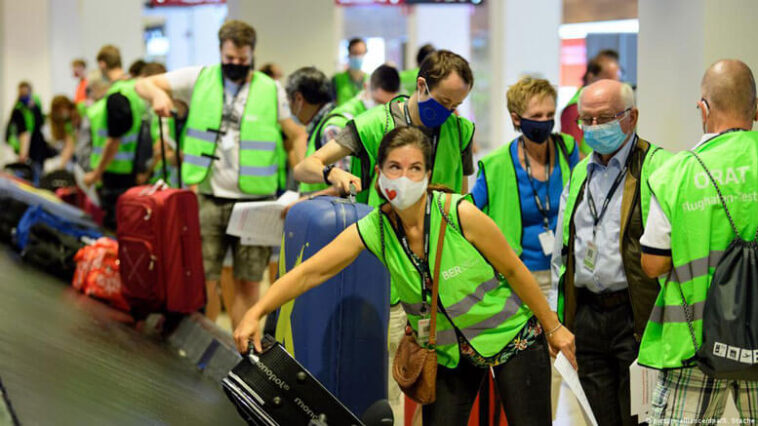he COVID-19 return to Germany when the number of cases starts to rise again
Summer is ending in Germany and COVID-19 cases are starting to increase again after a lull in infections over the summer months. The pandemic changed into declared officially over via the World Health Organization (WHO) earlier this 12 months. However, the recent uptick in instances has some Germans concerned about the functionality for a brand new wave of infections as we head into fall and winter.
In this article, we are able to look at the modern COVID situation in Germany, check the potential reasons behind the upward push in cases, and talk whether or now not this could signal the start of a unstable new segment of the pandemic in the USA.
Current COVID-19 Situation in Germany
Germany recorded a mean of around eight,000 new COVID-19 cases in step with day in the first week of September 2022, up from around five,000 instances in line with day in early August. The 7-day prevalence fee has risen to over 80 instances in keeping with a 100,000 human beings, up from round 60 in overdue August.
Hospitalizations have also started creeping upwards, with around 1,300 COVID patients admitted in one recent week compared to around 1,000 in late August. However, intensive care bed occupancy remains low, with around 180 COVID patients in ICU as of early September.
Overall, the COVID situation in Germany remains relatively stable and under control. The rise in cases has been gradual over the past month and has not yet placed major strain on the healthcare system.
Reasons for the Increase in Infections
There are several potential factors that may be contributing to the recent uptick in COVID-19 cases in Germany:
Relaxed Precautions
Many precautions like mask mandates and capacity limits on indoor spaces were rolled back over the summer as cases declined. People are socializing more freely and large events are being held again. This increased social mixing creates more opportunities for the virus to spread.
Waning Immunity
Immunity from vaccination or previous infection wanes over time. Those who were vaccinated early on or caught COVID last winter may now have lowering antibody levels, leaving them vulnerable to reinfection.
New Omicron Subvariants
New Omicron sublineages like BA.4 and BA.5 are gaining ground in Germany. These subvariants are more transmissible and better able to evade prior immune defenses.
Seasonality
Respiratory viruses tend to spread more easily in fall and winter months when people spend more time indoors in close proximity. Seasonal factors may now be spurring greater transmission.
Testing Changes
Official case counts have become less reliable as free citizen testing ended in Germany. Lower testing levels likely mean more mild infections are being missed.
Increased Travel
Summer holidays have led to more travel and interactions between people from different regions and countries, allowing variants to mix and spread.
Complacency
After two years of the pandemic, many people have pandemic fatigue and are not as vigilant about precautions. There may be a false sense of security that COVID is over.
Is This the Start of Another COVID Wave in Germany?
While the rising case counts are concerning, experts say it is still too soon to determine if this is the start of a dangerous new wave of infections in Germany.
Measured Perspective from Experts
Leading fitness officials and medical experts have furnished reassurance that the state of affairs remains beneath control for now.
For instance, Professor Stefan Kluge, Director of the Clinic for Intensive Care Medicine at the University Medical Center Hamburg-Eppendorf, stated:
“Half of the 182 people being treated in Germany for COVID-19 pneumonia are affected by the contagion. It is a very stable situation, even though we have observed more infections among staff and patients in recent weeks.”
Other experts have provided similar measured assessments, noting that cases are expected to fluctuate as we move into fall and calling for close monitoring while avoiding panic.
Role of Vaccines
One key difference from previous waves is the widespread vaccination coverage in Germany. Over 75% of the population is fully vaccinated.
While vaccine effectiveness wanes over time, vaccines still provide good protection against severe disease. This helps prevent hospitals from being overwhelmed even if cases rise. Booster doses will be important going into winter.
Milder Variants
The Omicron variant and its newer sublineages are more transmissible but typically cause less severe disease than earlier variants like Delta. This has prevented a spike in deaths and ICU burden so far.
Better Preparation
Authorities have had time to strengthen healthcare capacity and implement plans to quickly ramp up responses if needed. This includes boosting testing, treatments, surveillance and public messaging.
Targeted Mitigation Options
More narrowly targeted and less disruptive measures could be implemented to control local outbreaks and protect at-risk groups without resorting to widespread lockdowns. Options include increased testing requirements, masks, social distancing, and isolation of cases.
Germany’s Plan for Managing COVID in the Months Ahead
German officials have laid out a roadmap for navigating the pandemic in the coming months as cases fluctuate but the virus becomes endemic. Key elements include:
Transitioning to endemic phase
Treating COVID-19 as an endemic virus that will circulate at manageable levels rather than a pandemic emergency. Reduce disruptive restrictions while controlling spikes.
Monitoring and reacting
Closely tracking cases, hospitalizations, and deaths. Using indicators to trigger targeted mitigation measures in hotspots if needed to curb growth.
Vaccinations and boosters
Continuing vaccination programs, including promoting boosters and making updated vaccines available. Prioritizing vulnerable groups.
Testing and surveillance
Maintaining PCR and rapid testing capacity. Sequencing cases to detect new variants. Monitoring wastewater for outbreak early warning signs.
Treatment improvements
Stockpiling antivirals like Paxlovid. Developing post-infection clinics. Refining treatment protocols to reduce complications and deaths.
Protecting vulnerable settings
Using measures like improved ventilation, testing requirements and temporary masking to prevent spread in nursing homes, hospitals and other high-risk settings if community transmission increases.
Communication campaigns
Launching public education campaigns on topics like getting boosters, properly wearing masks, self-isolation when sick, and managing risks for vulnerable groups.
Preparing healthcare system
Ensuring adequate healthcare staffing and ICU capacity. Having contingency plans to scale up COVID responses if pressure on hospitals rises. Stockpiling equipment.
What Individuals Can Do for COVID-19
Experts recommend people continue taking common-sense precautions as we head into fall and winter:
- Get recommended vaccine doses and boosters
- Consider wearing masks in crowded indoor settings
- Stay home when sick
- Improve indoor ventilation and filtration where possible
- Practice good hand hygiene
- Test and isolate if symptomatic or exposed
- Consider avoiding large gatherings and travel if high risk
Continuing these basic mitigation steps can help keep infection levels in check as Germany aims to transition into the post-pandemic endemic phase.
Outlook for the 2022/2023 Winter COVID Season
It remains unclear how severe this winter’s COVID season will be in Germany and Europe as a whole. Scientists are monitoring the situation closely as cooler weather approaches.
Authorities should have reasonable warning to respond before healthcare systems are threatened. But individuals should also be prepared for potential disruptions.
With proper planning, ongoing vigilance and pragmatic responses as needed, Germany can continue moving out of the pandemic emergency phase while controlling periodic spikes in circulation of the COVID-19 virus.
Conclusion
Germany is seeing an increase in COVID-19 cases as summer draws to a close. However, the rise has been gradual so far and hospitalizations remain low. Leading experts say the situation is stable and does not warrant panic.
Several factors are likely contributing to the uptick, including waning immunity, new variants, seasonality, relaxed precautions and travel. Authorities are monitoring closely and have plans to respond with targeted measures if growth accelerates.
Vaccines, antivirals, prepared healthcare systems and milder virus strains make this phase of the pandemic more manageable. But risks still remain, especially for vulnerable groups. Germans are advised to take sensible precautions as COVID transitions into an endemic disease that will flare up periodically. With continued vigilance and pragmatism, the country can navigate through the endemic phase and seasonal surges ahead.
Get up-to-date on what’s happening in Nutrition and Health. Click Here.





